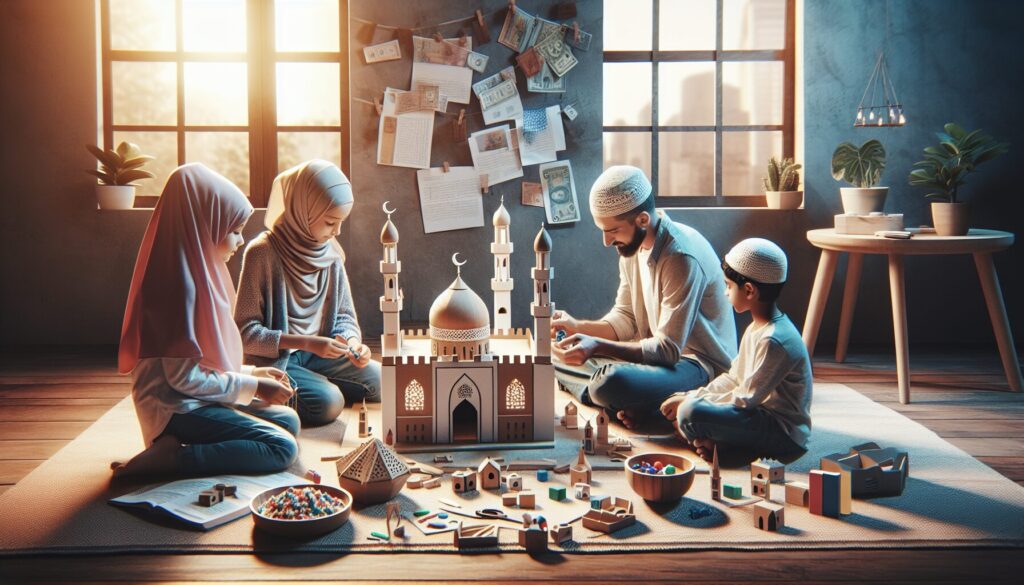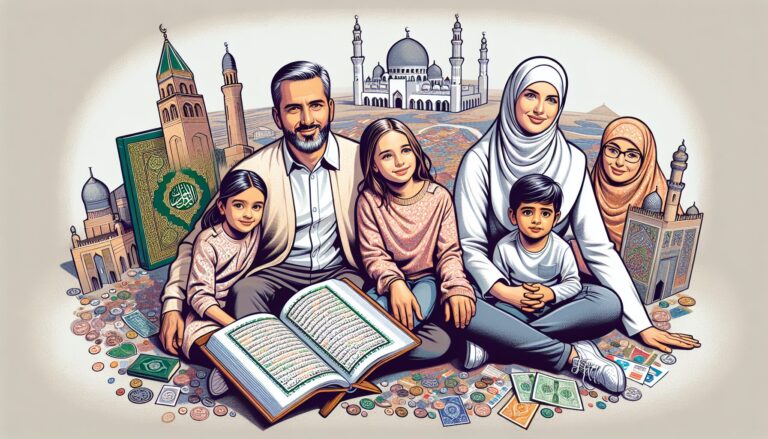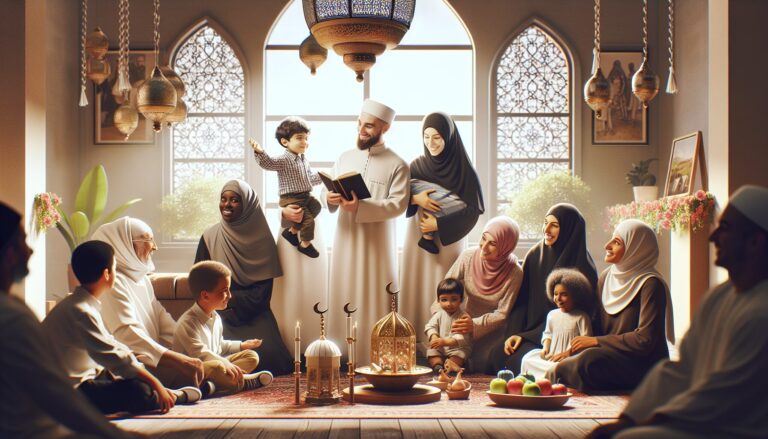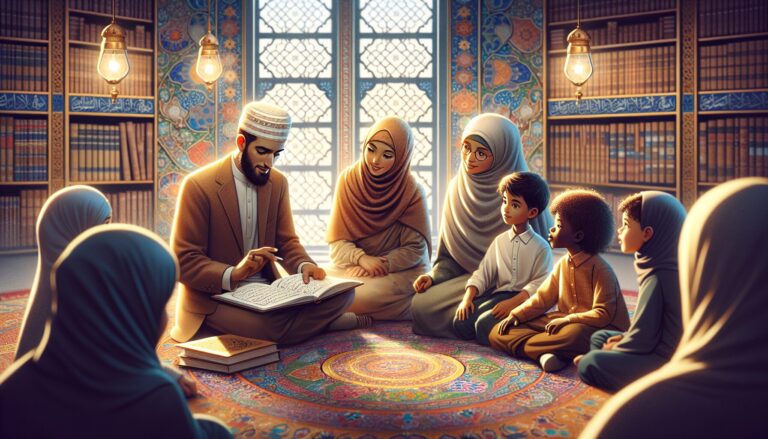Hey there, lovely readers! Let me tell you, one of my favorite memories from growing up in Canada was gathering around the kitchen table with my family for some weekend crafting. There’s something special about creating something beautiful with your own hands, especially when it’s infused with cultural significance. Islamic crafts are not only a delightful way to spend time with family, but they also offer a chance to explore and celebrate the rich tapestry of Islamic art and culture. From intricate geometric patterns to vibrant color palettes, Islamic crafts are like a burst of creativity that can light up any weekend. Plus, they’re a wonderful opportunity to teach kids about history and tradition in a fun and engaging way. So, grab your crafting tools, and let’s dive into a world of creativity!
Why Crafts Are Important for Families

Crafts are an awesome way to bring families together, especially on those cozy weekends when it’s too chilly to head outside. Gosh, I remember one winter Saturday when my family and I decided to dive into some crafting fun. We spread out on the living room floor, a mix of colored paper, glitter, and glue sticks scattered everywhere. It wasn’t just about creating something beautiful; it was about the laughter, the stories, and the occasional glue mishap that made the day unforgettable.
When you think about the importance of crafts for families, there are some key points to consider. First, they provide a fantastic opportunity for bonding. In our busy lives, finding activities that allow us to connect is crucial. Crafts encourage collaboration, communication, and learning together. Everyone gets involved, from the littlest family member to the eldest. Plus, crafting together often sparks conversations that help you learn more about each other.
Furthermore, crafts are a brilliant way to boost creativity and problem-solving skills. Kids and adults alike get to think outside the box, experimenting with colors, textures, and designs. This creative exploration is not just for fun; it’s an essential skill that helps in various aspects of life. Imagine the pride on your child’s face when they solve a tricky part of their project or come up with a unique idea!
Building Skills and Memories
Beyond creativity, crafts teach patience and perseverance. Let’s face it, not every project goes as planned. When something doesn’t work out, it’s a chance to learn and try again. This builds resilience, a valuable trait for facing life’s challenges. Additionally, crafting as a family instills these qualities in a supportive environment, making it a safe space to grow.
Now, let’s not forget the educational benefits. Many crafting activities can be sneakily educational. You can integrate math, science, and even history into your projects. For instance, creating an Islamic geometric pattern could lead to a fascinating discussion about its historical and cultural significance, possibly inspiring a deeper interest in history and culture. Organizations like Islamic History Month Canada often highlight the importance of understanding and celebrating diverse traditions.
In Canada, where winters can be long and chilly, indoor activities like crafting are a lifesaver. They’re not only a great way to pass the time but also to create lasting memories. Imagine your home filled with little handmade treasures, each with its own story and memory attached. These crafts become cherished keepsakes, reminding you of precious family moments.
Moreover, engaging in weekend Islamic crafts for families can also be an enriching experience for those looking to connect more deeply with their cultural heritage. It’s a chance to explore and express cultural identity in a hands-on way. Groups like Canadian Council of Muslim Women often promote such activities to encourage cultural understanding and appreciation.
Craft 1: Creating Islamic Geometric Patterns
Crafting Islamic geometric patterns is a fantastic way to spend time with family while diving into a world of art and culture. These intricate designs are more than just pretty shapes; they’re a centuries-old tradition that brings families together in a creative and educational way. Imagine sitting around the kitchen table, colored pencils in hand, and working together to bring these mesmerizing patterns to life.
To get started, you’ll need some basic supplies. Gather paper, rulers, compasses, pencils, and colored markers or pencils. Using these tools, you’ll be able to create beautiful geometric designs that are both soothing and stimulating. Kids love the chance to see how simple shapes can transform into complex patterns with just a few lines and angles.
Steps to Create Your Pattern
Follow these simple steps to create your own Islamic geometric pattern:
- Choose Your Base Shape: Start with a simple shape like a circle or square. This will be the foundation of your design.
- Draw Guidelines: Use your ruler and compass to draw lines across your base shape. These lines will guide your pattern.
- Add Details: Begin adding smaller shapes along the guidelines. Think triangles, hexagons, or stars.
- Color It In: Once your pattern is complete, use colored markers or pencils to fill in sections. Be bold and creative!
Creating these patterns is more than just a craft; it’s an educational experience. It introduces concepts of symmetry, mathematics, and artistic expression. If you’re looking to enhance your weekend routines and support your kids’ growth through creative, structured activities, exploring these patterns can be incredibly beneficial. Check out our article on why weekend routines are so important for kids’ growth for more insights.
Additionally, this activity can be a wonderful way to connect with the broader community. Consider reaching out to local organizations like the Canadian Council of Muslim Women or participating in events during Islamic History Month Canada. These connections can provide inspiration and further learning opportunities for both kids and adults.
Have fun experimenting with different designs and colors. The joy of Islamic geometric patterns lies in their endless possibilities and the unique touch each family member can add. Whether you’re using these patterns to decorate your home or to simply enjoy a peaceful weekend afternoon, this craft is a delightful way to celebrate art and culture right here in Canada.
Craft 2: Designing Personalized Prayer Mats
Designing personalized prayer mats is a delightful way for families in Canada to create something both meaningful and beautiful over the weekend. Imagine sitting with your loved ones, sharing stories, and weaving those into a tapestry that reflects your family’s unique journey and faith. It’s not just a craft—it’s a bonding experience that leaves you with a tangible piece of your spiritual heritage.
To start, gather your materials: a plain mat, fabric paints, stencils, and brushes. Your local craft store, like Michael’s Canada, should have everything you need. The fun part is choosing designs and colors that resonate with your family. Maybe you’re inspired by brilliant blues and golds reminiscent of the intricate patterns seen in historic mosques. Or perhaps, you prefer a more modern twist with bold geometrics in vibrant hues. This is where creativity truly shines!
Steps to Craft Your Personalized Prayer Mat
- Prepare the Mat: Lay your mat flat and smooth out any wrinkles. This will ensure an even application of paint.
- Select Your Design: Use stencils for precision or freehand if you’re feeling adventurous. This is a great time to incorporate simple geometric patterns, which can add a touch of elegance.
- Paint with Care: Apply fabric paint with gentle, steady strokes. Encourage everyone to take turns painting sections to make it a true family endeavor.
- Let it Dry: Once your masterpiece is complete, allow the paint to dry thoroughly. This might be a good time to share a meal together, discussing what each design element means to your family.
- Seal Your Work: For added durability, consider applying a fabric sealant. This ensures that your mat will last longer, preserving those cherished memories.
This craft not only nurtures creativity but also provides a wonderful opportunity for family reflection. As you create, discuss the significance of prayer and how it is woven into the fabric of your daily lives. Engaging with organizations like Canadian Council of Muslim Women can provide additional insights and inspiration, enriching the experience further.
Once your prayer mat is finished, it becomes a personalized symbol of your family’s faith journey. Display it proudly in a special place in your home, where it can serve as a daily reminder of the love and creativity shared during its creation. Crafting together is a beautiful way to spend quality time, and when combined with the teachings from Islamic History Month Canada, it becomes an enriching cultural experience for all.
Craft 3: Making Decorative Lanterns
There’s something magical about creating decorative lanterns, especially when it’s a family activity. Picture this: a cozy Saturday afternoon in Canada, the aroma of warm drinks in the air, and the entire family gathered around the table, crafting beautiful lanterns. This activity isn’t just about making something pretty; it’s a way to create lasting memories and connect with cultural traditions.
To kick things off, you’ll need a few supplies, and most of them can be found right at your local Michael’s Canada. Start with some colorful paper, scissors, glue, and LED tealights for a safe, flickering glow. If you’re feeling fancy, add some embellishments like stickers or glitter to make your lanterns truly one-of-a-kind.
Steps to Create Your Lanterns
- Choose Your Design: Let each family member pick a design. You could go for something simple or try your hand at an intricate pattern inspired by Islamic geometric patterns.
- Cut and Fold: Cut your paper into the desired shape and fold it into a cylinder. Secure the edges with glue or tape.
- Decorate: This is where the fun really begins! Use stickers, markers, or glitter to adorn the exterior. Let your creativity shine!
- Illuminate: Place an LED tealight inside the lantern. The gentle glow through the paper creates a warm and inviting ambiance.
Decorative lanterns have a special place in many cultural celebrations, and they’re perfect for adding a personal touch to your home during Islamic History Month Canada. This activity is also a fantastic way to teach kids about art and design, while reinforcing family bonds. Plus, it’s an opportunity to talk about the significance of light in various traditions, making it an enriching experience for everyone involved.
To make the most of this weekend Islamic craft for families, consider reaching out to organizations like the Canadian Council of Muslim Women for inspiration or guidance. They often have resources or events that can enhance your crafting experience.
Creating these lanterns offers a beautiful blend of art, culture, and family time, making it an ideal activity for a weekend in Canada. Whether you’re celebrating a special occasion or just looking for a fun way to spend time together, crafting these decorative lanterns is sure to light up your home and hearts.
Craft 4: Building Miniature Mosques

Creating miniature mosques is a delightful activity that brings families together for some creative bonding time. There’s just something magical about crafting a tiny version of these architectural wonders. Plus, it’s a great way to celebrate and appreciate the beauty of Islamic architecture right from the comfort of your home.
Start by gathering your materials. You’ll need some sturdy cardboard or foam board for the structure, craft paper for the decorative elements, and a bit of glue. Don’t forget scissors and a ruler for precise cuts. You can also get creative with paints and markers to add vibrant colors to your mosque. Remember, safety comes first, so ensure kids use child-safe scissors and have adult supervision when handling sharp objects.
Here’s a simple step-by-step guide to building your mosque:
- Design the layout: Sketch a basic outline of your mosque’s structure. Include elements like the dome, minarets, and main hall. Keep it simple yet elegant.
- Cut and assemble the pieces: Using your sketches, cut out the pieces from your cardboard or foam board. Assemble them carefully, ensuring each piece fits snugly.
- Decorate: This is where the magic happens! Use craft paper, paints, and markers to add geometric patterns and other designs. Let each family member contribute a unique element to personalize it.
- Add details: Use LED tealights to illuminate your mosque. It adds a warm glow, making your miniature creation even more enchanting.
Incorporating this activity into your weekend plans is a fantastic way to engage in Weekend Islamic Crafts for Families. Not only does it foster creativity, but it also provides an educational platform to discuss the significance of mosques. Moreover, it’s an excellent opportunity to talk about the rich history and cultural aspects of Islamic architecture. Organizations like the Canadian Council of Muslim Women often share resources and inspiration for such activities, adding depth to your crafting experience.
For those in Canada, consider visiting local craft stores like Michael’s Canada for all your supplies. They often have everything you need to bring your miniature mosque to life. You can even find inspiration by checking out Islamic History Month events, where creativity and culture beautifully intertwine.
Craft 5: Crafting Calligraphy Art
Crafting calligraphy art is an exciting way to explore creativity while connecting with the rich tapestry of Islamic culture. It’s all about transforming simple words into vibrant works of art. Imagine spending a cozy weekend afternoon with your family, surrounded by colorful inks and papers, as you all dive into the art of calligraphy. This craft is perfect for families in Canada looking to embrace and celebrate Islamic traditions together.
To start your calligraphy journey, you’ll need a few essential supplies. Gather some calligraphy pens or brushes, ink, and paper. For beginners, brush pens are a great choice because they’re easy to handle and come in various colors for added fun. Consider using high-quality paper to ensure your ink doesn’t bleed and ruin your masterpiece. You can find these materials at local craft stores like Michael’s Canada, where they often have a wide range of options to suit your needs.
Steps to Create Calligraphy Art
Creating calligraphy art can seem daunting, but breaking it down into manageable steps makes it more approachable.
- Choose Your Phrase: Pick a word or phrase that holds personal meaning. It could be something from Islamic texts or a phrase that inspires your family.
- Practice Basic Strokes: Start by practicing basic strokes. Understanding the pressure and flow of your pen or brush is crucial.
- Sketch Your Design: Lightly sketch your design on paper. This step helps you plan the layout and spacing.
- Begin Inking: Trace your sketch with ink, applying varied pressure to create the distinctive thick and thin lines of calligraphy.
- Embellish: Add decorative elements like geometric patterns or floral designs to enhance your piece.
Once you’ve completed your artwork, consider framing it. Displaying your calligraphy at home not only beautifies your space but also serves as a daily reminder of the values and traditions you cherish. For more inspiration and resources, organizations like the Canadian Council of Muslim Women often host workshops and events to help families like yours dive deeper into Islamic art forms.
Crafting calligraphy art is a delightful way for families to bond, learn, and grow together. It offers a chance to explore artistic talents while fostering a greater appreciation for Islamic culture. Whether you’re a beginner or seasoned artist, calligraphy is a rewarding activity that can be enjoyed by all ages. So, gather your family, unleash your creativity, and let the beauty of calligraphy fill your weekend with joy and inspiration.
Conclusion
Ultimately, engaging in weekend Islamic crafts provides families with invaluable opportunities to bond, learn, and explore cultural heritage through creativity. By participating in these activities, families can foster a deeper appreciation for Islamic art, build cherished memories, and nurture skills that will last a lifetime. So gather your loved ones, let your imagination flourish, and create something beautiful together. Happy crafting!
Continue Exploring
Transform your weekends with a perfect blend of fun and faith! Discover how to make Islamic teachings a cherished part of your children’s routine, ensuring their growth in both spirituality and joy. The ultimate checklist awaits to enrich your family’s weekends.
Frequently Asked Questions
What materials are needed for crafting Islamic geometric patterns?
To create Islamic geometric patterns, you’ll need paper, rulers, compasses, pencils, and colored markers or pencils. These tools will help you craft beautiful, intricate designs that are both educational and fun for the whole family.
How can crafting personalized prayer mats benefit my family?
Designing personalized prayer mats is a meaningful family activity that allows you to express your spiritual heritage creatively. It fosters bonding, encourages creativity, and provides a tangible piece of your family’s faith journey. Plus, it offers a way to discuss the significance of prayer in your daily lives.
Where can I find supplies for these Islamic crafts in Canada?
You can find most crafting supplies at local stores like Michael’s Canada. They offer a wide range of materials suitable for various crafts, from paper and paints for decorative lanterns to calligraphy pens and high-quality paper for calligraphy art.
Fatima Ansari is an Islamic educator and writer with over a decade of experience teaching Quran and Islamic studies to children and families in Western Muslim communities. Growing up in North America, she saw firsthand the challenges Muslim families face in balancing faith with modern life, which inspired her to share practical guidance rooted in the Quran and Sunnah. Her mission with E-Quran Learning is to make Islamic education accessible, relatable, and inspiring for Muslim families across the United States, United Kingdom, Canada, Australia, and New Zealand.






